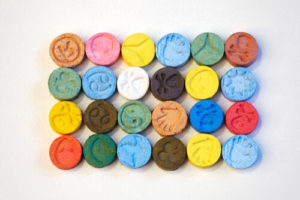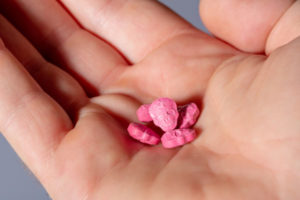There has been a slight shift in the demographics of ecstasy users from the 1990s to the present time.
Users today tend to be a bit older and better educated than in the past. This may reflect previous users just getting older instead of a major shift in the age of onset of first ecstasy use.
The purity of ecstasy and Molly appears to have declined over the years. Several different adulterants can be found in these drugs.
What Is Ecstasy?
Ecstasy is one of the street names for the substance MDMA, or 3,4-methylenedioxymethamphetamine. Other street names for the drug include Molly, X, XTC, or E.
The drug was discovered in 1912 by chemist Anton Kollisch. Ecstasy was used to produce another drug, methylhydrastinine, which was designed to control bleeding from the uterus.
Dow Chemical Company began researching the psychoactive compound in MDMA in the 1970s. Researchers later compared it to marijuana and other drugs that produce hallucinations.
MDMA found use with psychiatrists and psychotherapists, as it helped patients to overcome anxiety and gain insight into their own feelings. The drug was never subject to any clinical trials at this time, and it wasn’t approved by the Food and Drug Administration (FDA) for the treatment of any psychiatric disorder in the United States.
How Does MDMA Work?
Although the exact mechanism of action of MDMA is not fully understood, it is believed to primarily result in the release of two neurotransmitters in the brain, dopamine and serotonin. Other neurotransmitters are likely also affected.
The effects of the drug include increased feelings of empathy, euphoria, amplified energy, increased sexual desire, and the subjective feeling of enhanced perceptual abilities. The drug can also result in increased body temperature, rapid heartbeat, sweating, nausea, chills, and dry mouth.
When the effects of the drug begin to wear off, there is a depletion of the neurotransmitters that are activated by MDMA. People often begin to experience apathy, depression, and irritability.
Abuse of Ecstasy
MDMA has both stimulant and hallucinogenic effects. Recreational users came up with the street name ecstasy due to its unique set of effects, including hallucinations and feelings of sociability.
Eventually, the drug was placed on the Drug Enforcement Administration’s (DEA) list of controlled substances in the Schedule I category. This was due to a lack of valid evidence that it had medicinal effects and because it was considered to be a significant drug of abuse. Nonetheless, ongoing research studies suggest that MDMA does have clinical utility in the treatment of some psychological disorders like post-traumatic stress disorder (PTSD), but it is not approved for any of these purposes.
Despite being illegal to possess, the recreational use of MDMA began to grow in popularity in the late 1980s and early 1990s. It became known as one of the “rave drugs.”
Raves are parties that typically occur late at night and often include very loud music and pulsating light shows. Ecstasy’s ability to increase empathy and sociability make partygoers feel more connected with one another.
The drug also achieved some level of popularity on college campuses.
Trends of Ecstasy Use In the 1990s
Research studies that analyze yearly data on drug use, provided by the Substance Abuse and Mental Health Services Administration (SAMHSA) through its annual National Survey on Drug Use and Health (NSDUH), reveal facts on ecstasy use in the 1990s.
- Its use was highest among those 18 to 25 years old.
- The second highest rates of MDMA use were among those 26 to 34 years old.
- Those ages 12 to 17 years old ranked third highest.
- The lowest rates of MDMA use occurred in those over the age of 34.
In The 1990s, Ecstasy Use Rates:
- Were highest among Caucasians.
- Were second highest in those identifying as other (non-Caucasian, non-Hispanic, and non-African American).
- Were third highest in those identifying as Hispanic.
- Were lowest in those identifying as African American.
Ecstasy use was significantly more common in males than in females over the decade. Use of ecstasy increased over all age groups in the 1990s, peaking around 2000 to 2001.
Ecstasy Use In The 2000s
According to research on the use of ecstasy in the decade from 2000 to 2010:
- The 18-to-25 group continued to use the most ecstasy. About 60 percent of all people admitting to ecstasy use were in this group across the decade.
- The 26-to-34 age group had the second highest rate of ecstasy use across the decade, with 22 to 23 percent of those who admitted to using ecstasy in this group.
- The 12-to-17 age group had the lowest rate of ecstasy use, with only about 16 to 17 percent of those admitting to using ecstasy in this age group.
People identifying as Caucasians remained the largest group of ecstasy users across the decade, with about 62 to 64 percent of all ecstasy users being Caucasian. People identifying as Hispanic were the second largest ethnic group, with about 15 to 19 percent. African Americans had the lowest percentage of ecstasy use, with 11 to 14 percent.
Over all demographic groups, men continued to have higher rates of ecstasy use than women, with a ratio of about 3:2 across the decade.
Ecstasy Use From 2010 to Present

From about 2011 until about 2017, there was a slight alteration in the above trends.
The 12-to-17 age group saw a slight decline in the number of individuals using ecstasy, from about 16 percent of all ecstasy users in 2012 to about 9.6 percent in 2014. A 7.5 percent increase occurred in the 26-to-34 age group. The number of African Americans using ecstasy also significantly decreased from 2010 to 2011 and onward.
Thus, ecstasy use appears to have increased in the 26-to-34 age group, which could represent the transition of long-term drug abusers into a higher age bracket, as opposed to individuals beginning to use ecstasy at later age.
One of the observations that supports this notion is that the prevalence of ecstasy use over this time was relatively stable at about 2 percent.
Data From The Monitoring The Future Study
The data provided by the University of Michigan’s Monitoring the Future surveys, which investigate the use of drugs in younger individuals and changing attitudes about drugs, confirms a recent decline in the use of ecstasy by younger individuals.
The Following Trends of Ecstasy Use Were Found In the Data:
- Ecstasy use had a strong growth rate in the late 1900s, as use of the drug by high school seniors doubled from 1998 to 2000.
- Use among young people peaked in 2000 and then began to decline in 2003.
- Overall use among adolescents has remained steady since about 2003, at a rate of about 4 to 5 percent.
- Higher rates of use are associated with a perceived easier ability to get ecstasy.
- Education appears to be a significant factor in the decline in ecstasy use among young people. As young people express a greater awareness of the dangers of using the drug, their use of ecstasy also declines.
Over time, ecstasy users have gotten older, more educated, and less likely to report low income levels. Caucasians have consistently remained the largest ethnic group that uses ecstasy. In most cases, male users outnumber female users.
Ecstasy use is higher in urban areas. Rates of use are fairly consistent across the major regions of the United States.
Other research indicates that the use of ecstasy in high school students demonstrates some parallels to the data mentioned above. For instance, white males living in urban areas who come from middleclass or upper-income families are more likely to use ecstasy than other groups of adolescents and young adults.
Recent Use
According to the 2017 data published by SAMHSA:
- In 2016, about 2,485,000 people over the age of 12 admitted to past-year use of ecstasy. In 2017, this number was 2,487,000.
- In 2016, 177,000 people between the ages of 12 and 17 admitted to past-year use of ecstasy. In 2017, this number was 174,000.
- In 2016, 1,223,000 people between the ages of 18 to 25 admitted to past-year ecstasy use. In 2017, this number was 1,209,000.
- In 2016, 834,000 individuals between the ages of 26 and 34 admitted to past-year use of ecstasy. In 2017, this figure was 773,000.
- In 2016, about 250,000 people who were at least 35 years old admitted to past-year ecstasy use. In 2017, this figure was 330,000.
Consistent with the Monitoring the Future data, the biggest increase in past-year ecstasy use is among older individuals. Younger groups demonstrated a decline in ecstasy use, which would not suggest that people are starting to use ecstasy at an older age.
Has the Composition of Ecstasy Changed?
Pills that are sold on the street as ecstasy or Molly (a supposedly purer form of the drug) are expected to be made of MDMA.
MDMA is artificially produced. When drugs are artificially produced, the manufacturers may include cutting or bulking additives like sugar or lactose. This increases their profits.

In January 2018, the National Institute on Drug Abuse (NIDA) reported that many pills sold as ecstasy may not contain the same concentration of MDMA that pills contained in the past, or they may not contain any MDMA at all. In the past, ecstasy pills would typically contain 30 to 40 percent pure MDMA.
NIDA reports that other ingredients, such as para-methoxyamphetamine or PMA (a potentially dangerous synthetic hallucinogen), are often found in the powdered forms of ecstasy and even in some pill forms. Other drugs like synthetic cathinones (bath salts), ketamine, cocaine, amphetamine, piperazine, methamphetamine, or over-the-counter numbing agents have been found in products sold as ecstasy or Molly.
Pillreports.net is a database that focuses on ecstasy pills. The site’s researchers looked at the data of over 25,000 records collected between 2005 and 2017. They found that almost half of the pills inspected were debased in some form, and some versions of the drug contained no MDMA at all.
Due to the rise in adulterated ecstasy, there are different testing kits on the market, which are mostly sold online. These kits can be used to test the purity of the drug.
There is also some evidence that the purity of the drug is actually increasing in some states. However, the overall data suggests that less than a third of all the ecstasy pills sold street contain pure MDMA.

